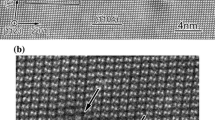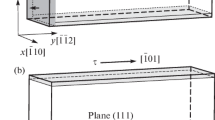Abstract
The present paper gives new experimental results that allow slow decomposition of metal azides of different types (including radiolysis, photolysis, electrolysis, and thermolysis) to be analyzed in the context of the common reaction pathway. Filamentary crystals of silver and lead azides are investigated. It is demonstrated experimentally that the reaction goes on the vacancy cluster formed by an edge dislocation in the near-surface region of the crystal. The reaction produces nonequilibrium electrons and holes considered as reactants. In the bulk of the crystal, the reaction in the anionic sublattice forms an intermediate product, hypothetically, N6. Methods of controlling the defect crystal structure of metal azides are suggested. They allow the reactivity of metal azides to be preset.
Similar content being viewed by others
REFERENCES
F. Boden and A. Ioffe, Fast Reactions in Solids [Russian translation], Inostrannaya Literatura, Moscow (1962).
B. P. Aduev, E. D. Aluker, G. M. Belokurov, et al., Izv. Vyssh. Uchebn. Zaved., Fiz., No. 11, 162-175 (1996).
Yu. A. Zakharov and E. D. Aluker, in: Proc. 1st Int. Congress on Radiation Physics, High-Current Electronics, and Modification of Materials, Vol. 1, Tomsk (2000), p. 2532.
V. G. Kriger and A. V. Kalenskii, Khim. Fiz., 14, No. 4, 152-160 (1995).
D. Yang, Kinetics of Decomposition of Solid Materials [Russian translation], Mir, Moscow (1996).
F. I. Ivanov, M. A. Lukin, and G. V. Nazarova, in: Mater. 3rd All-Union Conf. on Filamentary Crystals with Applications in Advanced Technology [in Russian], Voronezh (1979), pp. 181-184.
A. L. Kartuzhanskii, V. I. Krasheninin, L. V. Kuz'mina, and A. Yu. Stalinin, Pis'ma Zh. Tekh. Fiz., 20, No. 8, 1-3 (1994).
V. Yu. Zacharov, V. I. Krasheninin, L. V. Kuzmina, and Yu. A. Zakharov, Solid State Ionics, 101-103, 161-164 (1997).
H. G. Heal, Nature, 172, 30 (1953).
V. I. Krasheninin, V. Yu. Zakharov, and L. V. Kuz'mina, Khim. Fiz., 16, No. 5, 96-99 (1997).
V. I. Krasheninin, L. V. Kuz'mina, and V. Yu. Zakharov, Khim. Fiz., 16, No. 4, 74-77 (1997).
V. G. Kriger, A. V. Kalenskii, and L. G. Bulusheva, in: Abstracts of Reports at the 9th Int. Conf. on Radiation Physics and Chemistry of Inorganic Materials RPC-9 [in Russian], Tomsk (1996), pp. 224-225.
V. I. Krasheninin, A. I. Gasanov, and V. Yu. Zakharov, Paper deposited at VINITI [in Russian], No. 2662-B00, Moscow, October 19, 2000, 19 pp.
H. Trinks and N. Schilf, in: Techn. Pap. 7th Int. Colloq. Gasdyn. Explos. and React. Syst., New York (1979), pp. 242-252.
Author information
Authors and Affiliations
Rights and permissions
About this article
Cite this article
Zakharov, V.Y., Krasheninin, V.I., Gazenaur, E.G. et al. Physicochemical Processes in Heavy-Metal Azides and the Dislocation Structure. Russian Physics Journal 45, 553–557 (2002). https://doi.org/10.1023/A:1021191100748
Issue Date:
DOI: https://doi.org/10.1023/A:1021191100748




